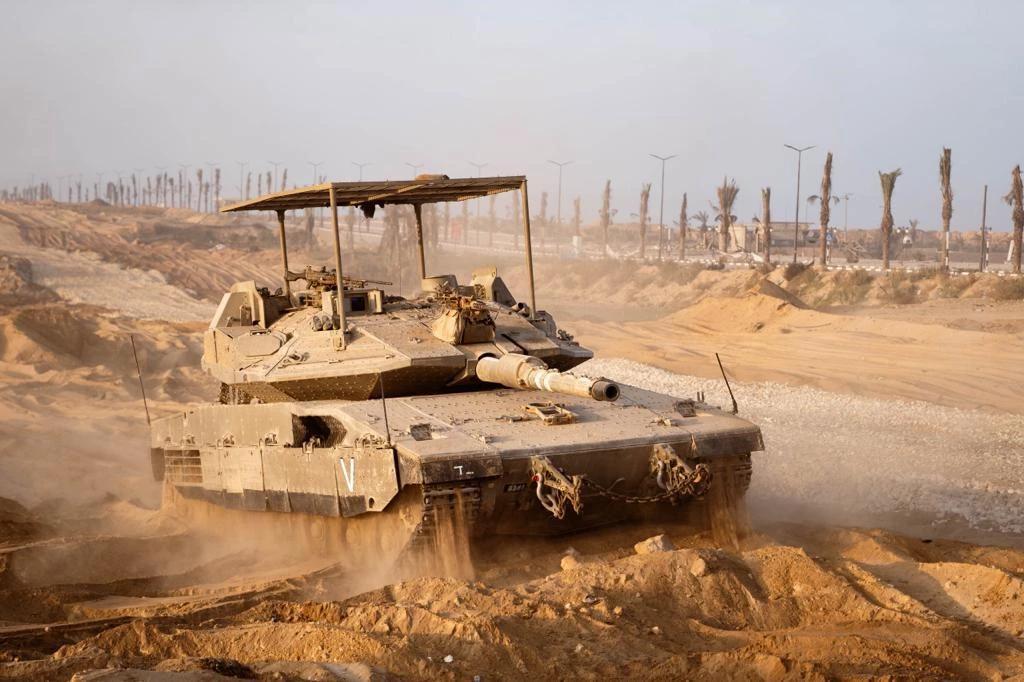Israel’s war in Gaza against Hamas has demonstrated the centrality of tanks in modern warfare, as effective ground battle trailblazers in urban Middle Eastern battlefields, with global ramifications for the future of armed conflict.
The high performance of Israeli armor – Merkava 4 tanks – despite coming under over an estimated thousand anti-tank missile attacks in Gaza since the start of the ground offensive on October 30, and the fact that not a single tank was destroyed at the time of this writing, has essentially laid to rest premature claims about the irrelevance of the main battle tank in 21st-century warfare.
Contrary to Hamas propaganda claims, even tanks that were hit by ATGMs and sustained damage were returned to the battlefield within hours – and not a single tank has been destroyed.
The integration of Rafael’s Trophy active protection system means the IDF’s tanks can punch through Hamas lines of defense and anti-tank ambush positions embedded in urban built-up regions, and even use the active protection system’s radar to help locate enemy positions and share them on the military digital command network – Elbit’s Torch 750 system, which provides real-time locations of enemy and friendly forces to commanders.
As a result, the war not only showcases the adaptability of armored units in urban settings but also severely undermines the perception of tanks as obsolete, a view that gained traction following the challenges faced by armor in the Ukraine War.
This advanced technology provided essential protection against a variety of ATGMs, a threat that has historically posed significant challenges to armored units. The Trophy system, with its ability to offer 360-degree protection, has been crucial in enabling the IDF to conduct offensive operations against Hamas with remarkable effectiveness.
The Trophy active protection system is also installed onboard Namer armored personnel carriers and has defended them.
The IDF has sent in hundreds of armored vehicles, tanks, and APCs, into Gaza. The one exception to the pattern described above thus far was the October 31 anti-tank missile strike on a Namer APC, which killed 11 Givati soldiers, at the start of the ground offensive. An after-action review of the incident concluded that a few hours before the deadly attack, the Namer was hit by an RPG which was neutralized by Trophy, but then, additional missiles were fired, one of which managed to crack the front end of the vehicle, and set off on-board weaponry. As a result, the IDF has removed this type of weaponry – a Matador anti-armor weapon – from the APCs.
On the whole, the usage of tanks and the Trophy system in Gaza stands in stark contrast to the experiences of armor in Ukraine, where Russian tanks have often been severely vulnerable to ATGMs and other anti-armor weapons.
It is also important to note that following Hamas’s use of quadcopters dropping explosives and grenades on October 7 to attack border patrol tanks, the Merkava 4 tanks were quickly fitted with a steel protective layer over the hatch.
Ultimately, the IDF’s experience in Gaza shows that with the right technology and tactical use, tanks can still play a crucial role in modern combat scenarios, even in the most challenging urban environments.
Moreover, the IDF’s strategy in deploying tanks in Gaza reflects a broader military approach that emphasizes the integration of various capabilities. While tanks play a pivotal role, their success is also dependent on the coordinated efforts of air, intelligence, and ground forces. This holistic approach to warfare is indicative of the evolving nature of military strategy, where synergy across different platforms and units is key to achieving operational objectives.
With the reestablished strategic and tactical relevance of armored units in contemporary warfare, the Swords of Iron War has demonstrated that tanks, when combined with advanced defensive technologies, can effectively navigate the complexities of modern battlefields. The IDF’s experience offers valuable insights into the future of armored warfare, and it is safe to assume that current clients of Trophy – the U.S. and German armies – as well as future potential clients, are closely following its performance.






